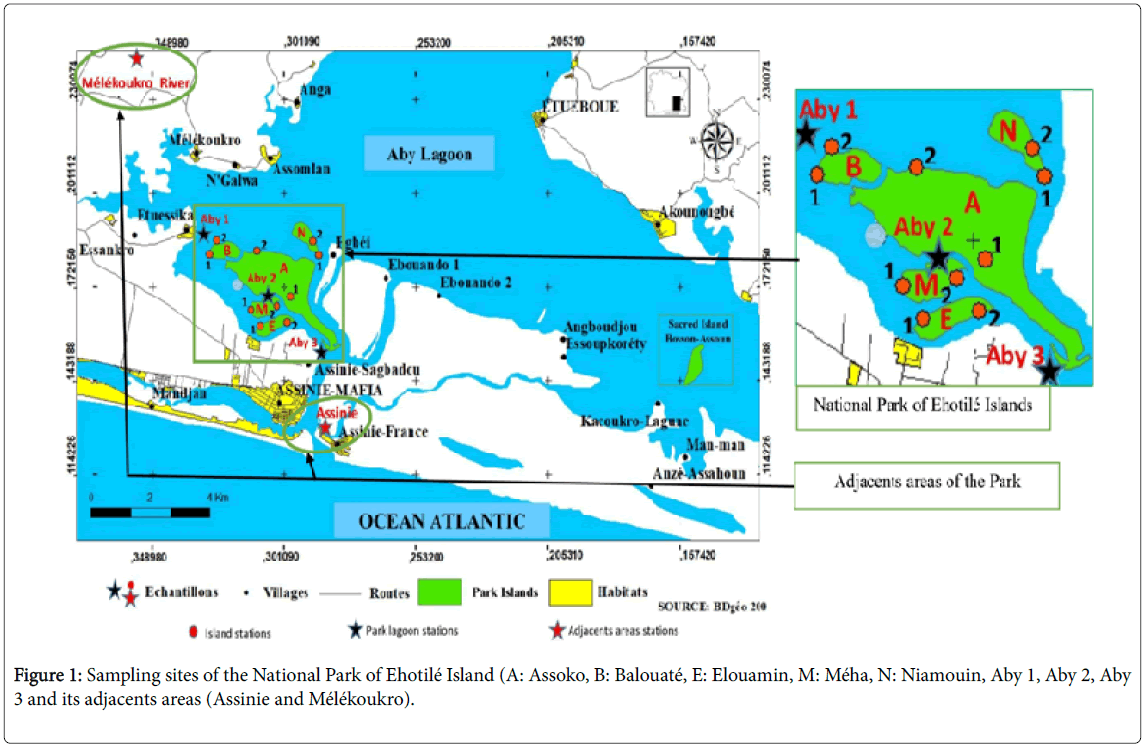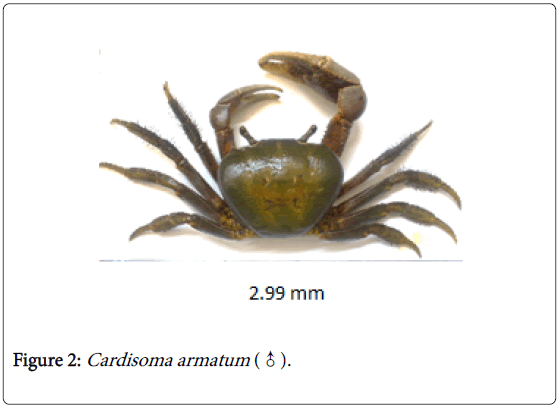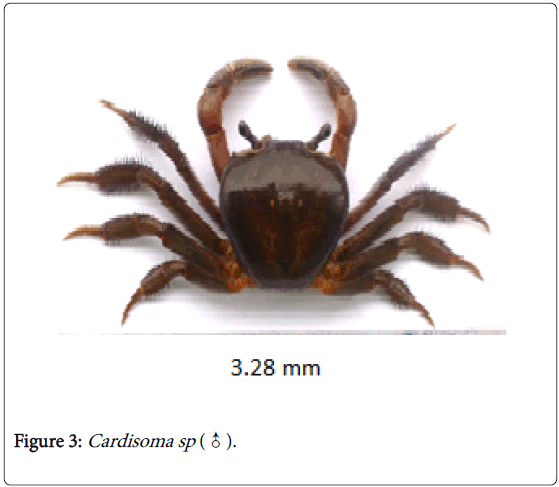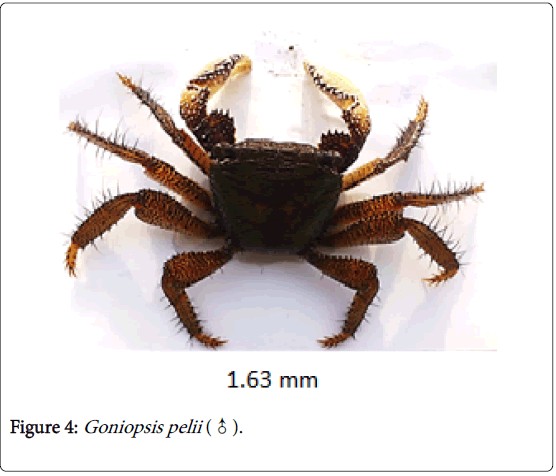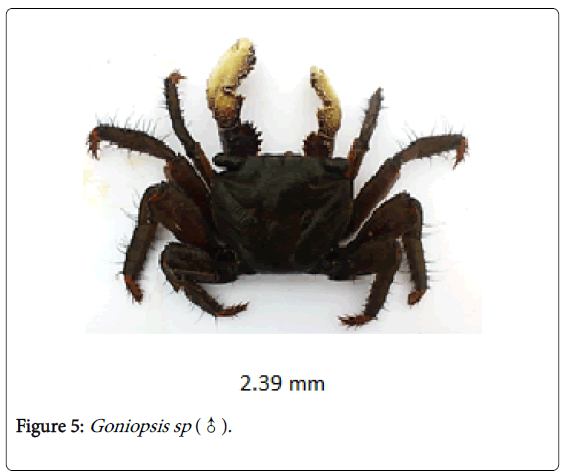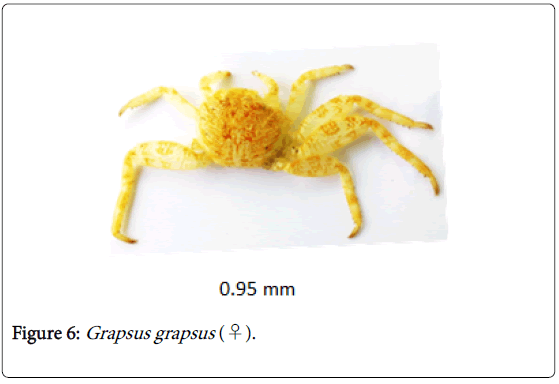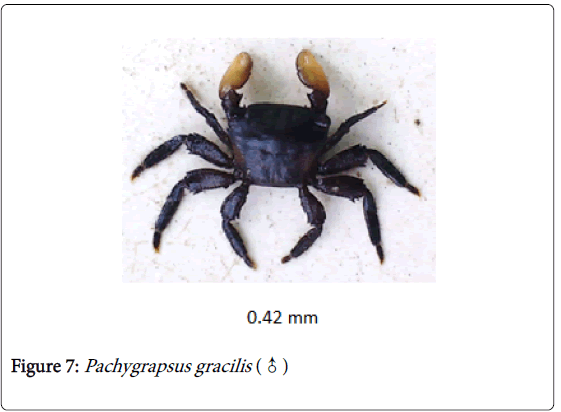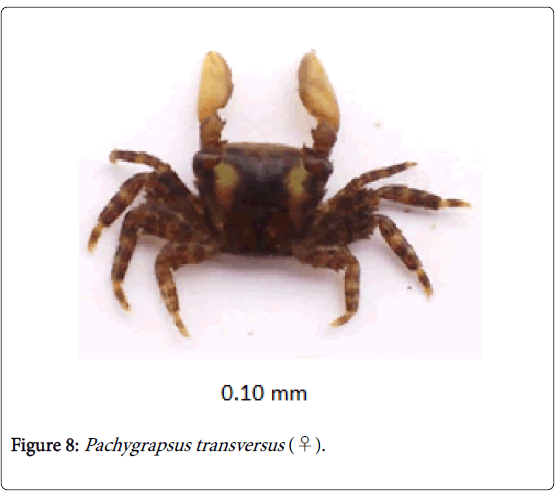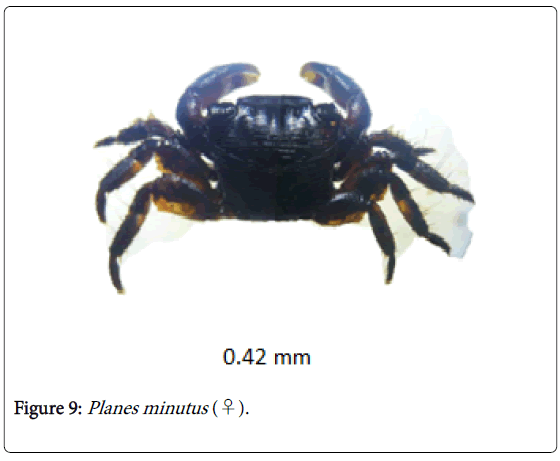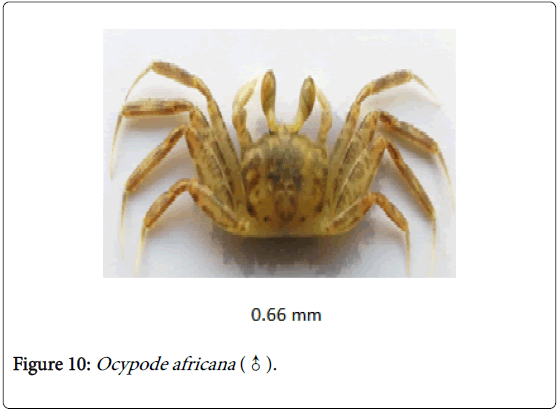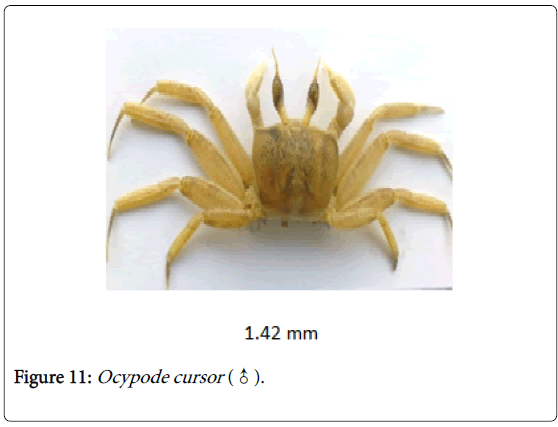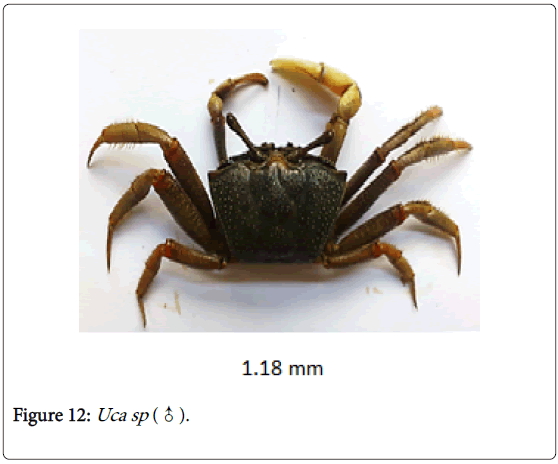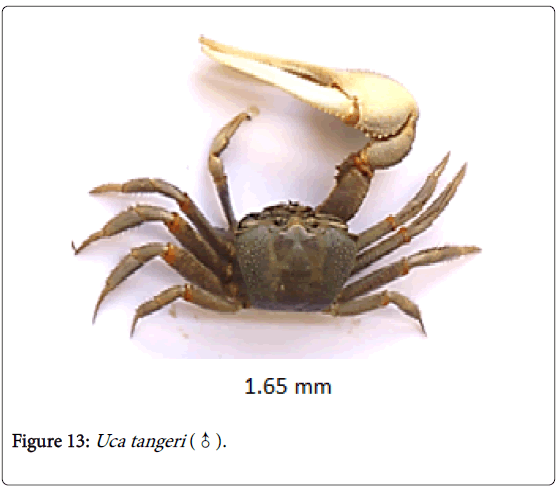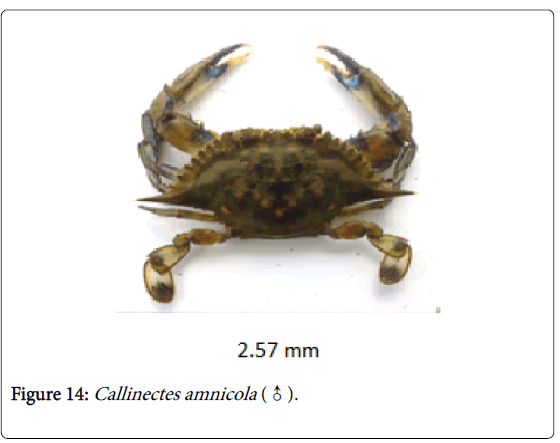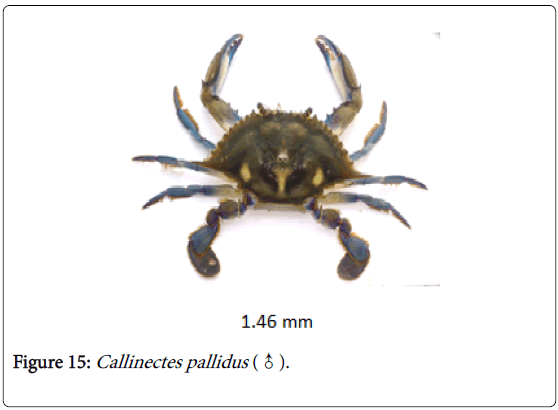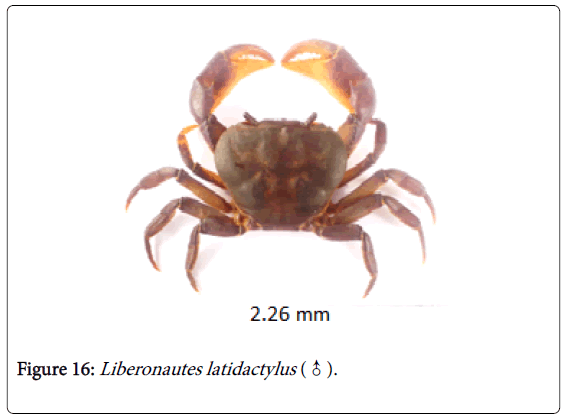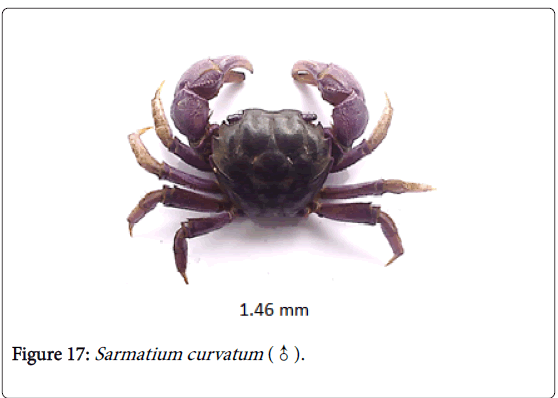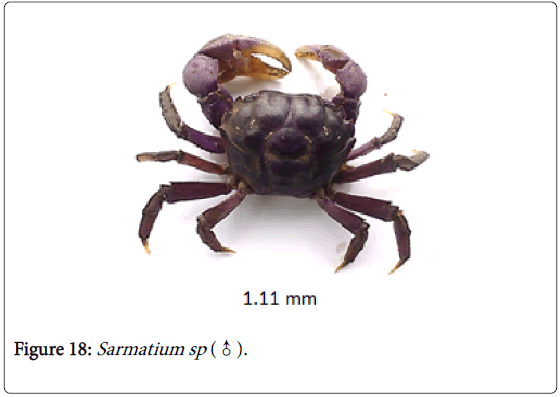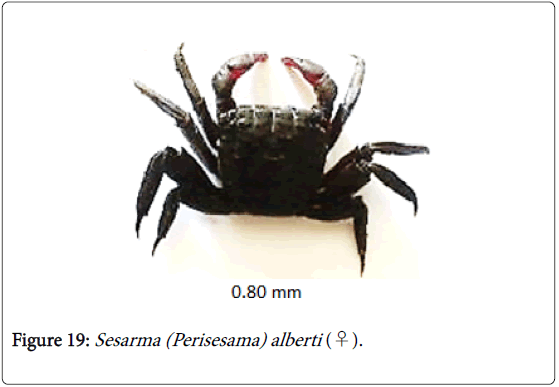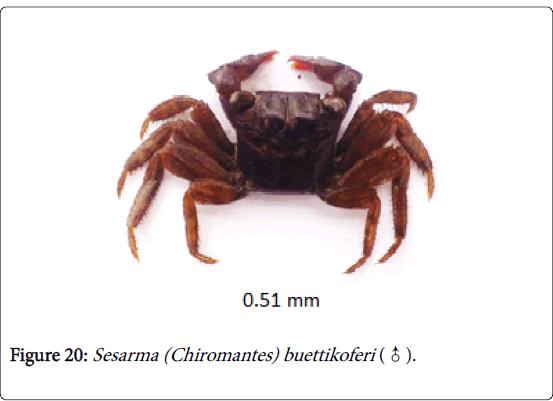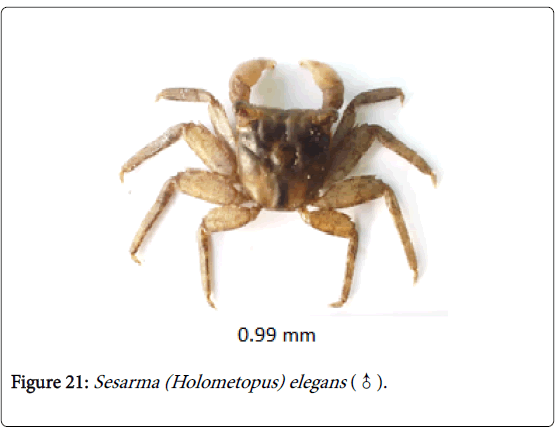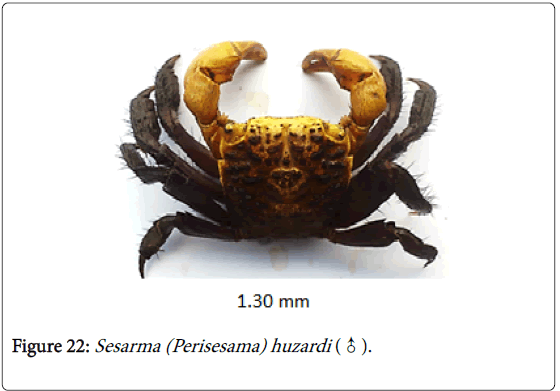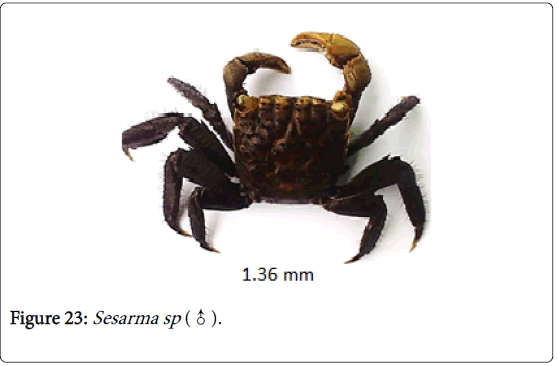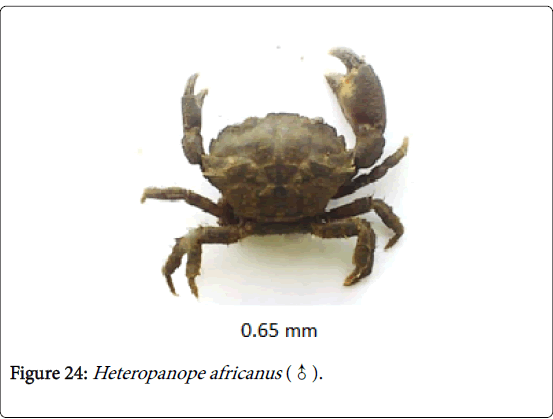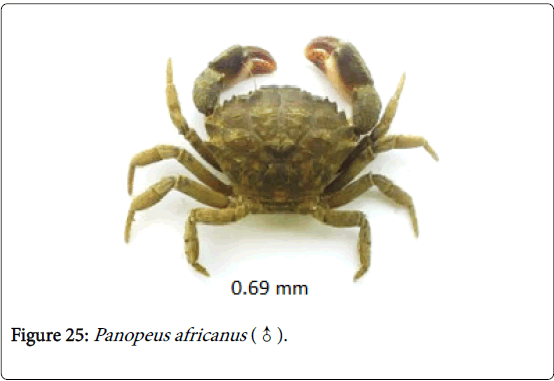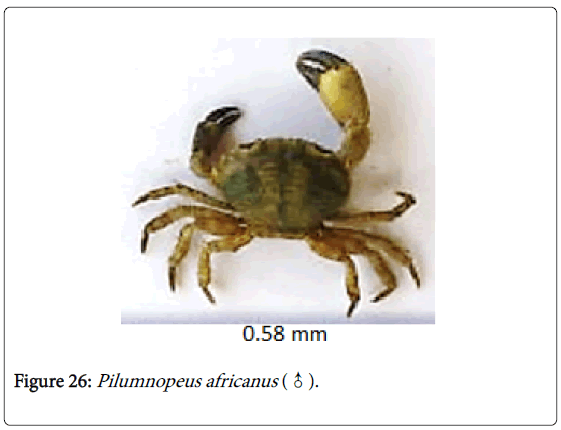Research Article, J Biodivers Manage Forestry Vol: 8 Issue: 3
Taxonomic Diversity of Crabs in the National Park of Ehotile Islands and its Adjacent Areas-at Cote D’ivoire-West Africa.
Coulibaly Lèfoungognon, N’ZI Konan Gervais*, Bodji Iridjé Marcelle and Ndouba Valentin
Department of Biosciences, Hydrobiology Laboratory, Felix Houphouet Boigny University, Abidjan, Cote D’Ivoire
*Corresponding Author : N ’ ZI Konan Gervais, Department of Biosciences
Hydrobiology Laboratory, Felix Houphouet Boigny University, 22 BP 582 Abidjan
22, Cote D ’ Ivoire
Tel: +225 07 65 87 22/+225 03 17 00 08; Email:
enzi_gervais@yahoo.fr/konan.n@univ-fhb.edu.ci
Received date: October 28, 2019; Accepted date: November 11, 2019; Published date: November 18, 2019
Citation: Coulibaly L, N ’ ZI Konan G, Bodji IM, Ndouba V (2019) Taxonomic Diversity of Crabs in the National Park of Ehotile Islands and its
Adjacent Areas-at Cote D’ivoire-West Africa. J Biodivers Manage Forestry 8:4. doi: 10.37532/jbmf.2019.8(3).218
Abstract
The aim of this study is to carry out an initial systematic inventory of crabs in the National Park of Ehotilé Island and its adjacent areas located in South East of Côte d’Ivoire in order to contribute to the knowledge of Côte d’Ivoire crabs. The study was conducted on species diversity, including their taxonomic position, morphological characteristics and geographic distributions. Crabs sampling was conducted monthly from January 2018 to March 2019. The fishing gears and technics used to catch crabs were balance crab fishing, traditional crab traps, fixednet, lobster pots, traps for water crabs and manual catch for land crabs. A total of 25 species belonging into 14 genuses and to 7 families were recorded in all sampling areas. Among these species, five (Cardisoma sp, Sesarma sp, Sarmatim sp, Goniopsis sp, Uca sp) were unidentified and one (Planes minutus) was identified for the first time in Côte d’Ivoire. The present study conducted for the first time in Côte d’Ivoire, is essential for the good policy of management and of sustainable use of this resource in Ehotile islands and its adjacent areas.
Keywords: Crabs; Taxonomic diversity; Spatial distribution; National Park of Ehotile Islands; Côte d’Ivoire; West Africa
Introduction
Crabs are a diversified subgroup of decapod crustaceans’ order [1]. Throughout the world, more than 6,800 species and subspecies have been inventoried [2]. Different species of crabs colonize a wide variety of trophic niches ranging from the marine environment, brackish and fresh waters to the firm ground [3]. Apart of their scientific interest, crabs play an important economic role [3,4], food and bio-ecological [5] and sanitairy [6].
Some species of crabs such as Callinectes amnicola and Cardisoma armatum are an important fishery resource for traditional communities live around the Aby lagoon in general and they are marketed in Côte d’Ivoire. However, the exploitation of some species might become attractive in the future with the increasing decline in populations of marketing crabs.
More than a popular item on seafood, Crabs are also offers a number of impressive health benefits, such as its ability to increase cognition, protect the heart, reduce inflammation, strengthen bones, boost the immune system, stimulate circulation, and detoxify the body [7,8]. Compared to another ecological communities such as fish and shrimp, which have been extensively studied, few scientific investigations have been conducted on crabs.
In Côte d’Ivoire, very scanty work has been reported on crabs except those of [9] on the biology and fishing of crabs of callinectes genus , [10] on the exploitable crustaceans, [11] on the mangrove ecosystems, [5] on the exploitation and bio-ecology of the swimming crab Callinectes amnicola , [4] on the comparative study of catch of Callinectes amnicola swimmer crabs, [1] on the general characters and histological study of the embryonic development of land crab, Cardisoma armatum and [12] on some ecological aspects of the gecarcinid land crab, Cardisoma armatum . All, these studies were focused on commercial species Callinectes amnicola and Cardisoma armatum.
However, no studies have yet been conducted to date on the inventory and distribution of crabs of Côte d'Ivoire. Therefore, the aim of the present study is to highlight the diversity of crabs and their distribution in the Ehotile Islands National Park and its adjacent areas in order to contribute to the updating of crab taxonomy of Côte d'Ivoire.
Methodology
Study area
The present study was carried out in the National Park of Ehotilé Islands and its adjacent areas (Figure 1). The park with an area of 722 ha, is located in the South East of Côte d’Ivoire in Adiaké department between the parallels 3°16'43" and 3°18'52" West longitude and 5°9'45" and 5°11'12" North latitude. It is composed to six islands [Assokomonobaha or Assoko (327.5 ha), Balouhaté (75 ha), Méha (45 ha), Nyamouin (47.5 ha), Elouamin (22.5 ha) and Bosson-Assoun (32.5 ha)]. These islands are surrounded by Aby Lagoon, which covers the catchment area of 305 km2 with an average depth of 4.6 m. This lagoon is characterized by low salinity of water in its eastern region. It receives the Bia River in its northern part and is connected to the Atlantic Ocean by the Assinie Canal in its southern part [13]. Adjacent areas of the park are the coastal areas represented by Assinie located between 3°16'78'' W and 5°7'84" N on one hand and Mélékoukro River located between the longitude 3°20'18" W and 5°13'58" N on other hand.
Sampled sites and crabs fishing gears
Fifteen stations were selected based on habitat diversity, their accessibility and the presence or absence of crabs in each area. Thirteen stations (Assoko 1, Assoko 2, Balouaté 1, Balouaté 2, Elouamin 1, Elouamin 2, Méha 1, Méha 2, Niamouin 1, Niamouin 2, Aby 1, Aby 2, Aby 3) were sampled in the park and two in the adjacent areas (Assinie and Mélékoukro River) (Figure 1).
Crabs were sampled monthly from January 2018 to March 2019 using crab balances, mesh net, fixed net, lobster pots and manual catch. In each sampling site, gears were set between 5:00 pm and 7:00 am for night catches, and between 7:00 am and 5:00 pm for day catches. Manual catches were done by digging crab burrows. Crabs captured were conserved into formaldehyde 10% and transported to the laboratory for identification. All cabs were identified using identification and determination keys of Manning et al. and Monod [14,15].
Data Analysis
For each specimen of crab, the measurements performed concern the carapace width (mm), the carapace length (mm), the carapace height (mm) and the length (mm) of different joints (Ischium, merus, carpus, palm and dactyl) of seconds chelipeds. Each crab was weighed to the nearest 0.01 g using a top loading Satorius balance (model BP 310S) and measured in millimeter using a numeric calliper model General, nearest 0.01.
Results and Discussion
The taxinomic study of crabs in the National Park of Ehotile Islands and its adjacent areas has put in evidence 25 species, these species belong to 14 genus and 7 families. The most diversified family is Sesarmidae with 7 species, followed by Grapsidae (6 species), Ocypodidae (4 species) and Xanthidae (3 species). Gecarcinidae and Portunidae families are each represented by 2 species. Potamidae family has the lowest specific diversity with only one species. Among species sampled, five (Cardisoma sp, Sesarma sp, Sarmatium sp, Goniopsis sp, Uca sp) were unidentified and one (Planes minutus) was identified for the first time in Côte d’Ivoire.
Taxonomic remarks: At the end of the observations and description, the families, genus and the species were grouped in alphabetical order and each species is described (morphometric meristic and color characteristics).
Family: Gecarcinidae (Macleay, 1838)
Genus: Cardisoma (Latreille, 1828)
Species: Cardisoma armatum (Herklots, 1851) (Figure 2): In males and females, carapace is transversely oval. Anterolateral margins of carapace are lacking teeth. Second chelipeds are asymmetrical. Color of chelipeds and leg varies from dark-brown to red with white fixed finger. Carapace varied from blue to brown. The carapace is 1.23 times broader than long and 3.65 time broader than the forehead length.
The length of the second chelipeds is 1.75 ± 0.15 to 1.31 ± 0.10 times the width of the carapace. Carapace width is 1.82 ± 0.21 to 2.56 ± 0.25 times the length of dacty l; 3.20 ± 0.45 to 5.67 ± 0.58 times the length of the palm; 2.87 ± 0.25 to 3.66 ± 0.39 times the length of the carp; 2.38 ± 0.75 to 2.60 ± 0.07 times the length of merus; 10.34 ± 1.06 to 12.84 ± 0.78 times the length of the ischium. The length of the largest cheliped is 1.34 ± 0.11 times than the smallest. The ratio between the width of the large palm and the small cheliped is 1.81 ± 0.28. Carapaces maximum widths observed are 93.53 mm for male (♂) and 81.24 mm for female (♀). The medium height of carapace is 27.11 mm.
Specimens were sampled in the stations Balouaté 2, Assoko 2, Niamouin 2, Méha 2 and Elouamin 2 in Ehotile National Park.
Cardisoma armatum was previosly recorded in Liberia, Cameroon, Senegal, Angola, Sierra Leone, Green Cape Island, Ghana, Gabon, Congo [14,15], Guinea [6], Benin [16], Togo, Nigeria and Côte d'Ivoire in Assinie, Aboisso, Adiake, Bassam, Bonoua, Abidjan, Dabou Sassandra, Fresco and San Pedro [1].
Species: Cardisoma sp (Figure 3):
The length of the second chelipeds is 1.44 ± 0.14 times the width of the carapace. Width of carapace is 2.33 ± 0.25 times the length of dactyl; 4.82 ± 0.77 times the length of the palm; 3.30 ± 0.29 times the length of the carp; 2.53 ± 0.40 times the length of merus; 11.35 ± 1.31 times the length of the ischium. The length of the largest cheliped is 1.08 ± 0.08 times than the smallest. The ratio of the width of the large palm to the small cheliped is 1.09 ± 0.11. Carapace width in the male (♂) varied from 54.21 to 82.48 mm and in the female (♀) from 40.29 to 71.34 mm. The medium height of carapace is 27.73 mm.
Specimens were sampled in the stations Balouaté 2, Niamouin 2, Méha 2 and Elouamin 2 in Ehotile National Park.
Family: Grapsidae (Macleay, 1838)
Genus: Goniopsis (De Haan, 1833)
Species: Goniopsis pelii (Herklots, 1851) (Figure 4).
Synonym: Goniopsis cruentata (Latreille, 1803): In both sexes, the carapace is squarish. Anterolateral margins have one tooth. Second chelipeds are morphologically similar and creamy white with a few purple marblings on the upper surface of the palm and of the base of the dactylus. Orange spot are observed on chelae articulations. Carapace is dark purple with a conspicuous and broad white band placed on its lateral part. The carapace is 1.22 times broader than long and 1.81 time broader than the forehead length.
The length of second chelipeds is 1.42 ± 0.14 width of the carapace. Carapace width is 2.78 ± 0.26 times the length of the dactyl; 3.54 ± 0.47 times the length of the palm; 3.49 ± 0.36 times the length of the carp; 2.51 ± 0.20 times the merus length; 12.04 ± 1.07 times the length of the ischium. The length of the largest cheliped is 1.03 ± 0.06 times than the smallest. The ratio of the width of the large palm to the small cheliped is 1.09 ± 0.14. Carapace width varied from 18.77 to 47.54 mm in the male (♂) and from 20.92 to 42.65 mm in the female (♀). The medium height of carapace is 13.19 mm.
Goniopsis pelii was previosly observed in Ehotile National Park into stations Balouaté 1, Assoko 1, Niamouin 1, Méha 1 and Elouamin 1. In Africa, Goniopsis pelii is recorded in Angola, Guinea Bissau, Senegal, Sierra Leone, Liberia, Congo, Zaire, Gabon, Ghana, Nigeria, Congo, Cameroon [15), Guinea [6], Senegal, Benin Gambia and Cote d’Ivoire[11].
Species: Goniopsis sp (Figure 5); In males, the carapace is squarish. Anterolateral margins have one tooth. Second chelipeds are morphologically asymmetrical and creamy white with a few purple marblings on the upper surface of the palm and of the base of the dactylus. There are also orange spot on chelae articulations. Carapace is dark purple with a conspicuous and broad white band on its lateral part. The carapace is 1.21 times broader than long and 1.90 time broader than the forehead length. The length of second chelipeds is 1.61 ± 0.02 to 1.27 ± 0.02 times the width of the carapace. Carapace width is 2.55 ± 0.21 to 3.23 ± 0.26 times the length of dactyl; 2.92 ± 0.02 to 3.93 ± 0.06 times the length of the palm; 3.10 ± 0.13 to 3.82 ± 0.14 times the length of the carp; 2.15 ± 0.06 to 2.76 ± 0.15 times the length of merus and 10.86 ± 0.58 to 11.60 ± 0.28 times the length of the ischium. The length of the largest cheliped is 1.26 ± 0.08 times than the smallest. The ratio between the width of the palm of the large and the small cheliped is equal to 1.53 ± 0.10. Carapace width varied from 42.22 to 45.7 mm in male (♂). The medium height of carapace is 15.65 mm.
Specimen was observed in Balouaté 1 station in Ehotilé National Park.
Genus: Grapsus (Lamarck, 1801)
Species: Grapsus grapsus (Linnaeus, 1758) (Figure 6).
Synonym: Grapsus pictus (Latreille, 1803); Grapsus maculatus (H. Milne Edwards, 1853); Grapsus pictus ocellatus (studer, 1883); Cancer jumpibus (Swire, 1938): In females, carapace is circular. Anterolateral margins of carapace possess one tooth. Second chelipeds are morphologically similar. Carapace is red brown color with circular white spots to regular outlines. The carapace is 2.84 times broader than length and 1.66 times broader than the forehead length.
The length of the second chelipeds is 0.75 ± 0.00 times the width of the carapace. The carapace width is 5.08 ± 0.03 times the size of the dactyl; 11.31 ± 0.27 times the length of the palm; 7.74 ± 0.10 times the length of the carp; 3.63 ± 0.02 times the length of merus; 15.80 ± 0.53 times the length of the ischium. The length of the largest cheliped is 1.01 times than the smallest. The ratio between the width of the palm of the large and the small cheliped is equal to 1.01. Carapace width ranged from 16.35 mm in the female (♀). The medium height of carapace is 4.07 mm.
This species was observed in Assinie station in adjacent area. Grapsus grapsus was known in Morocco, Liberia, Senegal, Angola, Guinea, Cape Verde Island, Ghana, Nigeria, Congo, Zaire, Cameroon and Côte d’Ivoire [14,15].
Genus: Pachygrapsus (Randall, 1840)
Species: Pachygrapsus gracilis (De Saussure, 1858) (Figure 7).
Synonym: Grapsus guadulpensis (Desbonne and Schramm, 1867); Males and females are characterized by: the carapace is squarish. The antero-lateral margins have one tooth. Second chelipeds are morphologically similar. The palm of the fingers is creamy color. Frontal margin is smooth and convex. Color of carapace varies from green-brown to black-brown. The carapace is 1.33 time braoder than long and 1.72 time broader than the forehead length. The length of the second chelipeds is 1.20 ± 0.12 times the width of the carapace. The carapace width is 3.08 ± 0.29 times the length of the dactyl; 4.12 ± 0.40 times the length of the palm; 4.13 ± 0.40 times the length of the carp; 3.20 ± 0.46 times the merus length; 13.30 ± 2.21 times the length of the ischium. The length of the largest cheliped is 1.02 ± 0.01 times than the smallest. The ratio between the palm width of the large and the small cheliped is 1.09 ± 0.02. In this study, carapace width varies from 8.48 to 11.45 mm in the male (♂) and from 8.35 to 10.02 mm in the female (♀). The medium height of carapace is 2.5 mm.
Pachygrapsus gracilis was previously observed in the Balouaté 1, Niamouin 1, Méha 1 and Elouamin 1 stations in Ehotile National Park. This species was recorded previously in Angola, Ghana, Nigeria, Congo, Zaire, [14,15], Guinea [6], Senegal, Benin Gambia and Côte d'Ivoire [11].
Species: Pachygrapsus transversus (Gibbes, 1850) (Figure 8).
Synonym: Goniograpsus innotatus (Dana, 1851); Leptograpsus rugulosus (H. Milne Edwards, 1853); Metopograpsus dubius (De Saussure, 1858); Metopograpsus miniatus (De Saussure, 1858); Grapsus declivifrons (Heller, 1862); Pachygrapsus intermedius (Heller, 1865); Pachygrapsus advena (Catta, 1876): In females, carapace is squarish. Anterolateral margins of the carapace have one tooth. Second chelipeds are morphologically similar. The palm of the fingers of these chelipeds is creamy color. Dorsal face is striated transversely and carries two furrows which delimit the point of the gastric area, granular and straight frontal margin.
The carapace is 1.20 times braoder than long and 1.80 times broader than the forehead length. The length of the second chelipeds is 1.09 ± 0.06 times the width of the carapace. Width of carapace is 4.23 ± 0.02 times the length of dactyl; 4.17 ± 0.06 times the length of the palm; 4.17 ± 0.06 times the length of the carp; 3.16 ± 0.02 times the length of merus; 9.50 ± 0.23 times the length of the ischium. The length of the largest cheliped is 1.08 times than the smallest. The ratio between the width of the palm of the large and the small cheliped is equal to 1.01. The carapace width observed is 5.32 mm for female (♀). The medium height of carapace is 3.38 mm.
This species was captured in Balouaté 1 station in Ehotile National Park. Pachygrapsus transversus was recorded in Angola, Morocco, Mauritania, Senegal, Sierra Leone, Ghana, Cape Verde Island, Ghana and Congo [14,15] and Guinea [6].
Genus: Planes (Bowdich, 1825)
Species: Planes minutus (Linnaeus, 1758) (Figure 9).
Synonym: Cancer pusilus (Fabricius, 1775); Grapsus pelagicus (Say, 1818); Plane clypeatus (Bowdich, 1825); Grapsus testudinum (Roux, 1828); Nautilograpsus major (Macleay, 1838); Nautilograpsus smithii (Macleay, 1838); Grapsus diris Costa, 1838-1853); Planes linnaeana (Bell, 1845): Females are characterized by: the carapace is squarish with transversals lines in the branchial region. Anterolateral margins of carapace have one tooth. Carapace color varies from greenish-brown to black-brown. Second chelipeds are morphologically similar and strong, Frontal region is large; the carapace is 1.19 times broader than long and 1.66 time broader than the forehead length.
The length of the second chelipeds is 1.32 ± 0.08 times the width of the carapace. Carapace width is 2.66 ± 0.12 times the length of dactyl; 3.51 ± 0.21 times the length of the palm; 3.88 ± 0.25 times the length of the carp; 3.19 ± 0.17 times the length of merus; 12.74 ± 2.73 times the length of the ischium. The length of the largest cheliped is 1.09 times than the smallest. The ratio between the width of the big palm of the large and the small cheliped is 1.08. The carapace width observed is 8.22 mm for female (♀). The medium height of carapace is 3.76 mm.
This species was captured in Assinie station in adjacent areas. Planes minutus was recorded in Gambia, Liberia, Cameroon and Benin [15].
Family: Ocypodidae (Rafinesque, 1815)
Genus: Ocypode (Weber, 1795)
Species: Ocypode africana (De Man, 1981) (Figure 10).
Synonym: Ocypoda hexagonura (Hilgendorf, 1882): In both sexes, the carapace is quadrangular. The antero-lateral margins are lacking teeth. Second chelipeds are morphologically similar. In the ocular pedoncul there are no horn and no hair brush. Carapace has beach sand color and it is redish in the cardiac région. The carapace is 1.30 times broader than long and 7.25 time broader than the forehead length. The length of second the chelipeds is 1.32 to 1.28 ± 0.04 times the width of the carapace.
The carapace width average is 2.77 ± 0.18 times the length of the dactyl; 3.94 ± 0.38 to 4.68 ± 0.11 times the length of the palm; 4.54 ± 0.37 to 4.61±0.35 times the length of the carp; 2.40 ± 0.21 to 2.40 ± 0.05 times the merus length; 14.84 ± 3.83 to 14.42 ± 4.43 times the length of the ischium. The length of the largest cheliped is 1.03 ± 0.04 times than the smallest. The ratio between the palm width of the large and the small cheliped is 1.52 ± 0.11. The carapace width varies from 6.71 to 16.38 mm in the male (♂) and from 6.35 to 15.83 mm in the female (♀). The medium height of carapace is 5.6 mm.
This species was captured in Assinie in adjacent areas. Ocypode africana was recorded in Mauritania, Angola, Guinea, Senegal, Liberia, Sierra Leone, Nigeria, Congo and Ghana [14,15].
Species: Ocypode cursor (Lineaeus, 1758) (Figure 11).
Synonym: Ocypode ippeus (Olivier, 1804): Both sexes are characterized by: the carapace is quadrangular; the antero-lateral margins are lacking teeth. Second chelipeds are morphologically similar. The Cornea is developed. It is two-thirds longer than the length of the eye. The ocular peduncle is extended by a brush of hair which is longer than the cornea. Carapace has beach sand color. The carapace is 1.29 times broader than long and 7.31 times broader than the forehead length. The length of the second chelipeds is 1.39 ± 0.02 to 1.24 ± 0.03 times the width of the carapace. The carapace width is 3.01 ± 0.20 to 2.92 ± 0.19 times the length of the dactyl; 3.73 ± 0.11 to 5.52 ± 0.11 times the length of the palm; 3.82 ± 0.25 to 4.46 ± 0.05 times the length of the carp; 2.34 ± 0.08 to 2.46 ± 0.08 times the merus length; 9.52 ± 0.17 to 12.13 ± 1.53 times the length of the ischium. The length of the largest cheliped is 1.03 ± 0.04 times than the smallest. The ratio between the palm width of the large and the small cheliped is 1.52 ± 0.11. The carapace width varies from 17.76 to 41.78 mm in the male (♂) and from 27.75 to 33.8 mm in the female (♀). The medium height of carapace is 13.82 mm.
This species was captured at Assinie station in adjacent areas.
Ocypode cursor was previously recorded in Angola, Mauritania, Cape Verde, Gabon, Guinea, Senegal, Liberia, Sierra Leone, Nigeria, Cameroon, Congo and Ghana [14,15] and Guinea [6].
Genus: Uca (Leach, 1814)
Species: Uca sp (Figure 12); In males, carapace is rectangular. The antero-lateral margins are lacking teeth. Second chelipeds are morphologically asymmetrical. The carapace is 1.46 times broader than length and 4.80 times broader than the forehead length. The length of the second cheliped is 2.02 ± 0.55 to 1.15 ± 0.03 times the width of the carapace. The average carapace width is 1.49 ± 0.47 to 3.13 ± 0.06 times the length of the dactyl; 2.74 ± 1.01 to 6.57 ± 0.01 times the length of the palm; 2.76 ± 0.91 to 4.69 ± 0.32 times the length of the carp; 2.26 ± 0.26 at 2.60 ± 0.12 times the merus length; 10.16 ± 1.20 to 11.96 ± 0.71 times the length of the ischium. The length of the largest cheliped is 1.76 ± 0.53 times than the smallest. The ratio between the palm width of the large and the small cheliped is 2.89 ± 1.10. The carapace width varies from 21.57 to 31.42 mm in the male (♂). The medium height of carapace is 9.96 mm.
This species was captured in Assinie station in adjacent areas.
Species: Uca tangeri (Eydoux, 1835) (Figure 13).
Synonym: Gelasimus perlatus (Herklots, 1851); Gelasimus cimatodus (De Rochebrune, 1883): In both sexes, carapace is rectangular. The antero-lateral margins are lacking teeth. Second chelipeds are morphologically asymmetrical. The carapace is granular and it color varies from purple to greenish. The carapace is 1.41 times broader than length and 4.64 times broader than the forehead length. In the male, the length of the second chelipeds is 3.00 ± 0.16 to 1.17 ± 0.04 times the width of the carapace. Average carapace width is 0.79 ± 0.06 to 3.07 ± 0.21 times the length of dactyl; 1.80 ± 0.06 to 6.26 ± 0.28 times the length of the palm; 1.90 ± 0.18 to 4.66 ± 0.29 times the length of the carp; 1.83 ± 0.08 to 2.54 ± 0.10 times the length of merus; 9.38 ± 1.18 to 13.66 ± 1.85 times the length of the ischium.
The length of the largest cheliped is 2.56 ± 0.12 times than the smallest. The ratio between the width of the palm of the large and the small cheliped is equal to 3.73 ± 0.16. In the female, second chelipeds are morphologically similar and are the same measurement of the small chelipeds of male. The carapace width varies from 26.04 to 38.51 mm in the male (♂) and from 23.33 to 29.08 mm in the female (♀). The medium height of carapace is 11.92 mm.
This species was captured in Assinie in adjacent area. Uca tangeri was recorded in Angola, Senegal, Guinea, Liberia, Gabon, Sierra Leone, Nigeria, Cameroun, Benin, Gambia, Côte d’Ivoire, Congo and Ghana [6,11,14,15].
Family: Portunidae (Rafinesques, 1815)
Genus: Callinectes (Stimpson, 1860)
Species: Callinectes amnicola (De Rochebrune, 1883) (Figure 14).
Synonym: Neptunus edwardsi (De Rochebrune, 1883); Callinectes latimanus (Rathbun, 1897); Neptunus marginatus var. truncata (Aurivillius, 1898): In both sexes, carapace hexagonal, anterolateral margins with nine teeth. Second chelipeds are morphologically asymmetrical. The anterior part of fingers is blue. Carapace is green brown uniform and moderately convex. The posterior part of the epibranchial ridges has small granules. The gonopods of males are very elongated, reaching almost the end of the abdomen.
The carapace is 2.24 times broader than length and 5.48 times broader than the forehead length. The length of the second chelipeds is 1.12 ± 1.34 to 1.07 ± 1.34 width of the carapace. Carapace width is 4.49 ± 0.69 to 4.66 ± 0.82 times the length of dactyl; 4.68 ± 0.78 to 5.09 ± 0.91 times the length of the palm; 5.95 ± 0.92 to 6.40 ± 1.07 times the length of the carp; 3.69 ± 0.61 at 3.81 ± 0.69 times the length of merus; 14.35 ± 3.35 to 16.28 ± 4.55 times the length of the ischium. The length of the largest cheliped is 1.05 ± 0.06 times than the smallest. The ratio of the width of the large palm to the small cheliped is 1.22 ± 0.20. The carapace width varies from 44.74 to 152.84 mm in the male (♂) and from 47.45 to 140.87 mm in the female (♀). The medium height of carapace is 18.34 mm.
This species was captured in Aby 1, Aby 2 and Aby 3 stations in Ehotile National Park. Callinectes amnicola was recorded in Congo, Cap Verde, Senegal, Gambia, Ghana, Nigeria, Cameroon [14] and [15], Benin [16] and Côte d’Ivoire [4].
Species: Callinectes pallidus (De Rochebrune, 1883) (Figure 15).
Synonym: Callinectes tumidus var. gladiator (Benedict, 1893): Males and females are characterized by: The carapace is hexagonal. Antero-lateral margins of carapace have nine teeth. Carapace color varies from green-grey to blue-grey. First gonopods of male is short. Presence of granules on both the sides of the epibranchial line. Second chelipeds are morphologically similar. The carapace is 2.51 times broader than length and 6.46 times broader than the forehead length. The length of second chelipeds is 0.85 ± 0.07 times the width of the carapace. Carapace width is 4.99 ± 0.52 times the length of dactyl; 5.28 ± 0.56 times the length of the palm; 6.62 ± 0.85 times the length of the carp; 3.92 ± 0.34 times the length of merus; 20.86 ± 5.60 times the length of the ischium. The length of the largest cheliped is 1.07 ± 0.14 times than the smallest. The ratio of the width of the large palm to the small cheliped is 1.13 ± 0.14. The carapace width varies from 40.86 to 89.13 mm in the male (♂) and from 41.77 to 80.41 mm in the female (♀). The medium height of carapace is 7.24 mm.
This species was capturedin Aby 1, Aby 2 and Aby 3 stations in Ehotile National Park. Callinectes pallidus was recorded in Mauritania, Angola, Senegal, Ghana, Nigeria, Libéria, Sierra Leone [14,15], in Guinea [6] and Côte d’Ivoire [11].
Family: Potamidae (Arnold Edward Ortmann, 1896)
Genus: Liberonautes (Bott, 1955)
Species: Liberonautes latidactylus (De Man, 1903) (Figure 16): Males and females are charaterized by: the carapace is transversely oval. Second chelipeds are morphologically homogeneous. Carapace surface is granular. Its color varies from yellow to greenish. Presence of intermediate tooth between the exorbitary and the epibranchial terminal part of the first gonopod facing outwards is observed. The carapace is 1.43 times broader than length and 3.20 times broader than the forehead length. The length of the second chelipeds is 1.44 ± 0.08 times the width of the carapace. The carapace width is 2.27 ± 0.20 times the length of the dactyl; 3.91 ± 0.37 times the length of the palm; 3.18 ± 0.23 times the length of the carp; 2.79 ± 0.16 times the merus length; 13.45 ± 0.79 times the length of the ischium. The length of the largest cheliped is 1.03 ± 0.02 times than the smallest. The ratio between the palm width of the large and the small cheliped is 1.11 ± 0.05. The carapace width varies from 27.14 to 57.61 mm for male (♂) and from 38.34 to 59.95 mm in female (♀). The medium height of carapace is 14.87 mm.
This species was captured in Mélékoukro station in adjacent areas. Liberonautes latidactylus was recorded in Guinea [6].
Family: Sesarmidae (Dana, 1851)
Genus: Sarmatium (Dana, 1851)
Species: Sarmatium curvatum (H. Milne Edwards, 1837) (Figure 17): In both sexes, the carapace is squarish. Antero-lateral margins possess two teeth. Dactylus and sternits are yellowish. The carapace is curved. It is violet-purple color with convex side edges. Second chelipeds are morphologically similar. The carapace is 1.25 times broader than length and 2.13 times broader than the forehead length. The length of the second chelipeds is 1.78 ± 0.82 times the width of the carapace. The carapace width is 2.12 ± 0.70 times the length of the dactyl; 4.42 ± 1.34 times the length of the palm; 2.66 ± 0.64 times the length of the carp; 2.39 ± 0.54 times the merus length; 10.95 ± 2.68 times the length of the ischium. The length of the largest cheliped is 1.19 ± 0.10 times than the smallest. The ratio between the palm width of the large and the small cheliped is 1.33 ± 0.32. The carapace width varies from 13.72 to 38.26 mm in the male (♂) and from 20.65 to 25.01 mm in the female (♀). The medium height of carapace is 11.15 mm.
This species was captured in Balouaté 1, Assoko 1 and Méha 1 stations in Ehotile National Park. Sarmatium curvatum was previously recorded in Sénégal, Angola, Guinée, Sierra Leone, Gabon and Congo [15].
Species: Sarmatium sp (Figure 18): In males, the carapace is squarish. Anterolateral margins have two teeth. Second chelipeds are morphologically asymmetrical. Dactylus and sternits are yellowish. The carapace is curved. It is violet-purple color. The lateral edges of carapace are convex with two teeth behind external orbital teeth. The carapace is 1.25 times broader than the lemgth and 2.05 times broader than the forehead length. The length of the second chelipeds is 1.72 ± 0.33 to 1.41 ± 0.22 times the width of the carapace. The carapace width is 1.82 ± 0.29 to 2.46 ± 0.49 times the length of the dactyl; 4.02 ± 1.43 to 5.97 ± 1.24 times the length of the palm; 2.52 ± 0.50 to 2.87 ± 0.48 times the length of the carp; 2.46 ± 0.26 to 2.64 ± 0.26 times the merus length; 10.95 ± 2.46 to 10.53 ± 1.15 times the length of the ischium. The length of the largest cheliped is 1.21 ± 0.03 times than the smallest. The ratio between the palm width of the large and the small cheliped is 1.65 ± 0.08. The carapace width varies from 21.46 to 33.71 mm in the male (♂). The medium height of carapace is 12.34 mm.
This species was captured in Balouaté 1 and Méha 1 stations in Ehotile National Park.
Genus: Sesarma (Say, 1817)
Species: Sesanna (Perisesama) alberti (Rathbun, 1921) (Figure 19): In females, carapace is squarish. The antero-lateral margins of carapace have one tooth. Second chelipeds are morphologically quite similar and red color with about thirty furrows on the dactyl. Carapace is dark. The carapace is 1.18 times broader than the length and 1.65 times broader than the forehead length. The length of second chelipeds is 1.25 ± 0.01 times the width of the carapace. Carapace width is 3.14 ± 0.03 times the size of dactyl; 4.71 ± 0.08 times the length of the palm; 3.38 ± 0.04 times the length of the carp; 2.82 ± 0.02 times the length of merus; 14.49 ± 0.77 times the length of the ischium. The length of the largest cheliped is 1.02 times than the smallest. The ratio between the width of the palm of the large and the small cheliped is 1.01 mm. The carapace width is 19.26 mm in the female (♀). The medium height of carapace is 7.59 mm.
This species was captured in Elouamin 1 station into Ehotilé National Park. Sesanna albertiis was recorded in Angola, Liberia, Sierra Leone, Nigeria, Congo [14,15], Guinea [6], Benin and Côte d’Ivoire [11].
Species: Sesarma (Chiromantes) buettikoferi (De Man, 1883) (Figure 20): In both sexes, carapace is squarish. The antero-lateral margins are lacking teeth. The carapace is black with dark-red task. Second chelipeds are morphologically substantially homogeneous. Chelipeds color contrasted strongly with the purplish blue. Palm extending laterally beyond carpal articulation and the dactyls are red. The carapace is 1.19 times broader than the length and 1.61 times broader than the forehead length. The length of second chelipeds is 1.52 ± 0.08 times the width of the carapace. The carapace width is 2.68 ± 0.20 times the length of the dactyl; 2.95 ± 0.25 times the length of the palm; 3.38 ± 0.28 times the length of the carp; 2.28 ± 0.10 times the merus length; 13.63 ± 1.71 times the length of the ischium. The length of the largest cheliped is 1.03 ± 0.01 times than the smallest. The ratio between the palm width of the large and the small cheliped is 1.06 ± 0.06. The carapace width varies from 11.05 to 12.92 mm in the male (♂) and from 10.52 to 12.44 mm in the female (♀). The medium height of carapace is 4.81 mm.
This species was captured in Assoko 2, Niamouin 1 and Elouamin 2 stations in Ehotile National Park. Sesarma buettikoferi was recorded in Liberia, Angola, Cameroon, Nigeria, Congo [14] and Côte d’Ivoire [11].
Species: Sesarma (Holometopus) elegans (Herklots, 1851) (Figure 21): In both sexes, the carapace is rectangular. Antero-lateral margins of carapace are lacking teeth. The walking legs are blue-grey with slightly purple spots. Branchial region is grey with black task. The end of dactylus is white and the carapace is greenish. Second chelipeds are morphologically similar. The carapace is 1.06 time broader than the length and 1.67 times broader than the forehead length. The length of second chelipeds is 1.37 ± 0.20 to 1.21 ± 0.12 width of the carapace. Carapace width is 2.75 ± 0.60 to 3.15 ± 0.39 times the length of dactyl; 4.47 ± 1.01 to 5.08 ± 0.89 times the length of the palm; 3.56 ± 0.63 to 4.23 ± 0.64 times the length of the carp; 2.54 ± 0.21 to 2.72 ± 0.15 times the length of merus; 13.28 ± 1.11 to 13.04 ± 0.80 times the length of the ischium. The length of the largest cheliped is 1.20 ± 0.04 times than the smallest. The ratio of the width of the large palm to the small cheliped is 1.34 ± 0.16. The carapace width varies from 14.85 to 19.66 mm in the male (♂) and from 12.35 to 19.01 mm in the female (♀). The medium height of carapace is 7.11 mm.
This species was captured in Balouaté 1, Assoko 2, Niamouin 1, Méha 1 and Elouamin 1 stations in Ehotile National Park. Sesarma elegans was recorded in Angola, Gabon, Sierra Leone, Nigeria, Congo, Zaïre, Ghana [14,15], Guinea [6], Gambia and Côte d’Ivoire [11].
Species: Sesarma (Perisesama) huzardi (Desmarest, 1825) (Figure 22)
Synonym: Sesarma africana (H. Milne Edwards, 1837): In males and females, the carapace is squarish. The antero-lateral margins of the carapace have long teeth. Second chelipeds are morphologically homogeneous. The carapace is 1.16 times broader as long as and 1.76 times broader than the forehead length. In young specimens the carapace is dark. Carapace becomes yellowish in older specimens.
The length of the second chelipeds is 1.62 ± 0.24 width of the carapace. Width of carapace is 2.18 ± 0.41 times the length of dactyl; 3.75 ± 0.55 times the length of the palm; 2.81 ± 0.36 times the length of the carp; 2.39 ± 0.25 times the length of merus; 10.38 ± 1.30 times the length of the ischium. The length of the largest cheliped is 1.01 ± 0.01 times than the smallest. The ratio of the width of the large palm to the small cheliped is 1.03 ± 0.03. The carapace width varies from 26.12 to 41.1 mm in the male (♂) and from 26.46 to 37.07 mm in the female (♀). The medium height of carapace is 13.65 mm.
This species was captured in Balouaté 1, Assoko 1, Niamouin 1, Méha 1 and Elouamin 1 stations in Ehotile National Park. Sesarma huzardi was recorded in Liberia, Cameroun, Bénin Angola, Guinea, Sierra Leone, Ghana, Nigeria, Congo Zaïre [14,15], Guinea [6], Senegal, Benin, Gambia and Côte d’Ivoire [11].
Species: Sesarma sp (Figure 23): In males, the carapace is squarish. Antero-lateral margins of carapace possess one long tooth. Second chelipeds are morphologically asymmetrical and dark colored often pale yellow. The carapace is dark. The carapace is 1.14 times broader than the length and 1.76 times broader than the forehead length.
The length of the second chelipeds is 1.76 ± 0.19 to 1.56 ± 0.17 the width of the carapace. Width of carapace is 2.14 ± 0.62 to 2.18 ± 0.29 times the length of dactyl; 3.27 ± 0.26 to 4.12 ± 0.47 times the length of the palm; 2.51 ± 0.24 to 2.92 ± 0.29 times the length of the carp; 2.25 ± 0.11 to 2.43 ± 0.14 times the merus length; 9.16 ± 0.34 to 10.14 ± 1.00 times the length of the ischion. The length of the largest cheliped is 1.12 ± 0.11 times than the smallest. The ratio between the palm of the large and the small cheliped is 1.26 ± 0.12. The carapace width varies from 30.28 to 35.51 mm in the male (♂). The medium height of carapace is 16.59 mm.
Sesarma sp was captured in Balouaté 1 and Elouamin 1 stations in Ehotile National Park.
Family: Xanthidae (Macleay, 1838)
Genus: Heteropanope (Stimpson, 1858)
Species: Heteropanope africana (De Man, 1902) (Figure 24): In males and females, the carapace is transversely oval. Antero-lateral margins have four teeth. Anterolateral teeth are well cut and more or less pointed. Second chelipeds are morphologically asymmetrical. The dactyls are black color and white-tinged close to the claws. The carapace is 1.46 times broader than the length and 2.91 times broader than the forehead length. The length of the second chelipeds is 1.46 ± 0.14 to 1.10 ± 0.05 times the width of the carapace.
The carapace width is 2.71 ± 0.47 to 3.62 ± 0.15 times the length of the dactyl; 2.59 ± 0.37 to 4.05 ± 0.26 times the length of the palm; 2.99 ± 0.31 to 3.95 ± 0.42 times the length of the carp; 3.69 ± 0.43 to 3.98 ± 0.28 times the merus length; 11.98 ± 1.13 to 13.89 ± 2.61 times the length of the ischium. The length of the largest cheliped is 1.32 ± 0.16 times than the smallest. The ratio between the palm width of the large and the small cheliped is 1.59 ± 0.21. The carapace width varies from 12.38 to 24.33 mm in the male (♂) and from 12.22 to 16.7 mm in the female (♀). The medium height of carapace is 4.23 mm.
This species was captured in Balouaté 1, Assoko 1, Méha 1 and Elouamin 1 station in Ehotile National Park. Heteropanope africana was recorded in Cameroon and Côte d’Ivoire [15].
Genus: Panopeus (H. Milne-Edwards, 1834)
Species: Panopeus africanus (A. Milne-Edwards, 1867) (Figure 25): In males and females, the carapace is transversely oval. The antero-lateral margins have four teeth. Second chelipeds are morphologically similar. The antero-lateral teeth are horizontal and the last tooth is pointed obliquely. Carapace color varies from darken grey to brown. Fixed fingers are colored black and white. The carapace is 1.46 times broader than the length and 3.39 times broader than the forehead length. The length of second chelipeds is 1.40 ± 0.08 to 1.27 ± 0.10 times the width of the carapace. The carapace width is 2.85 ± 0.26 to 3.07 ± 0.35 times the length of the dactyl; 2.87 ± 0.29 to 3.61 ± 0.30 times the length of the palm; 2.81 ± 0.14 to 3.13 ± 0.30 times the length of the carp; 3.64 ± 0.25 to 3.58 ± 0.15 times the merus length; 13.61 ± 0.85 to 14.41 ± 1.20 times the length of the ischium. The length of the largest cheliped is 1.10 ± 0.03 times than the smallest. The ratio between the palm width of the large and the small cheliped is 1.30 ± 0.07. The carapace width varies from 11.68 to 45.32 mm in the male (♂) and from 19.94 to 29.00 mm in the female (♀). The medium height of carapace is 7.36 mm.
This species was captured in Balouaté 1, Assoko 1, Niamouin 1, Méha 1 and Elouamin 1 stations in Ehotile National Park. Panopeus africanus was recorded in Angola, Libéria, Mauritania, Guinea, Gabon, Sierra Leone, Nigeria [14,15] Senegal, Benin Gambia and Côte d’Ivoire [11].
Genus: Pilumnopeus (A. Milne-Edwards, 1863)
Species: Pilumnopeus africanus (De Man, 1902) (Figure 26): In males, carapace is transversely oval. The antero-lateral margins of the carapace have four strongly teeth. Second chelipeds are morphologically asymmetrical. The dactylus and fixed fingers are white colored. Carapace is dark grey to brown color. The carapace is 1.44 times broader than the length and 3.24 times broader than the forehead length. Second chelipeds is 1 to 2.10 times the width of the carapace. The carapace width is 3.65 to 2.72 times the length of the dactyl; 4.76 to 2.38 times the length of the palm; 3.95 to 2.91 times the length of the carp; 4.36 to 3.96 times the length of the merus; 27.14 1.38 times the length of the ischium. The length of the largest cheliped is 2.09 times that of the smallest. The ratio between the palm width of the large and the small cheliped is 2.10. The carapace width is 13.57 mm for the male (♂). The medium height of carapace is 3.95 mm.
This species was captured in Elouamin 1 station in Ehotile National Park. Pilumnopeus africanus was recorded in Guinea, Cameroon Nigeria, Liberia, Gabon [14,15] Senegal, Benin Gambia and Côte d’Ivoire [11].
Conclusion
This study allowed characterizing the crabs’ population of Cote d'Ivoire. It appears that 25 species inhabit the Park National of Ehotile Islands and its adjacent areas. It also highlights five unidentified species (Cardisoma sp, Sesarma sp, Sarmatim sp, Goniopsis sp, Uca sp) and one species (Planes minutus) recorded for the first time in Côte d’Ivoire.
More research is needed to understand their distribution according to environmental variables, reproductive biology of the most abundant species and, identification and nomenclature of indeterminate species. Also, a regular monitoring of catches will be necessary to better assess fishing pressure on some large species such Cardisoma amatum and Callinetes amnicola in the adjacent areas of the Park.
Results of this study are relevant and could be used as database for the assessment of stocks and the management of crabs ’ fisheries around National Park of Ehotile islands (Côte d’Ivoire). This study will also create a database and a collective ability to address issues for species loss before they arise.
References
- Dâ�?�?almeida MA, Koua HK, Ouattara-Soro SF, Fantodji AKC, Ehouman A, et al. (2014) Caract�?¨res g�?©n�?©raux et �?©tude histologique du d�?©veloppement embryonnaire du crabe terrestre, cardisoma armatum, herklots, 1851 (decapoda gecarcinidae) de C�?´te dâ�?�?Ivoire. Afrique SCIENCE 10: 338-355.
- Peter KLNg, Davie PJF, Guinot D (2008) Systematic Brachyurous: Part 1. An Annotated checklist of extant Brachyuran crabs of the world. The Raffles Bulletin of Zoology 17: 1-286.
- Cartes JE, Fanelli E, Papiol V, Maynou F (2010) Trophic relationships at intrannual spatial and temporal scales of macro and megafauna around a submarine canyon of the Catalonian coast (western Mediterranean). Journal of Sea Research 63: 180-190.
- Sankar�?© Y, Amalatchy NJ, Koffie-Bikpo CY (2014) Etude comparative des captures de crabes nageurs callinectes amnicola (Decapoda-Portunidae) des lagunes ivoiriennes (Afrique de lâ�?�?ouest). Rev Cames 1: 75-84.
- Sankar�?© Y (2007) Exploitation et bio�?©cologie du crabe nageur Callinectes amnicola Rochebrune, 1883 (Decapode-Portunidae) dans le complexe lagunaire Aby-Tendo-hy (C�?´te dâ�?�?Ivoire-Afrique de lâ�?�?Ouest). Th�?¨se Unique de lâ�?�?Universit�?© dâ�?�?Abidjan-Cocody, U F R Biosciences, Universit�?© de Cocody 320.
- Cumberlidge N (2006) Inventaire rapide des crustac�?©s d�?©capodes de la pr�?©fecture de Bok�?© en Guin�?©e. Rapid Assessment Program (RAP) Bulletin of Biological Assessment/Bulletin RAP dâ�?�?Evaluation Rapide 41, Conservation International, Washington DC. Chapter 3: 38-46.
- Junzeng X, Nanshan D, Wei L, Huixian W (1997) A review of studies on Portunus trituberculatus in China. Dongahi Marine Science 15: 60-65.
- Skonberg DI, Perkins BL (2002) Nutrient composition of green crab (Carcinus maenus) leg meat and claw meat. Food Chemistry 77: 401-404.
- Emmanuel CD, Saurin H (1981) Biologie et peche des crabes du genre callinectes stimpson, 1860 (decapodes, portunidae) en lagune ebrie (C�?´te dâ�?�?ivoire). R�?©sultats pr�?©liminaires. Doc Sci Centre Reche Oc�?©anogr 12: 95-121.
- Durand JR, Philippe D, Daniel G, Soko GFZ (1994) Environnement et ressources aquatiques de Cote-d��?Ivoire. Tome II ��? Les milieux lagunaires. �?�?ditions de l��?ORSTOM.
- Guiral D, Albaret JJ, Baran E, Bertrand F, Debenay JP, et al. (1999) Rivi�?¨res du Sud: Soci�?©t�?©s et mangroves ouest africaines. �?�?ditions de lâ�?�?ORSTOM 1: 63-130.
- Etchian OA, Dakouri R, Bl�?© CM, Lawal-Are AO, Cuesta AJ (2016) Some ecological aspects of the gecarcinid land crab, Cardisoma armatum Herklots, 1851 (Crustacea, Brachyura, Gecarcinidae) from the estuarine region of the Comoe River, C�?´te dâ�?�?Ivoire. International Journal of Biological and Chemical Sciences 10: 457-474.
- Chantraine JM (1980) La lagune Aby (C�?´te d'Ivoire): Morphologie, hydrologie, param�?¨tres physico-chimiques. Doc Sci Centre Rech Oc�?©anogr Abidjan 11: 29-77.
- Manning RG, Holthuis LB (1981) West African Brachyuran Crabs. (Crustacea: Decapoda). Smithsonian Contributions to Zoology 306: 1-379.
- Monod T (1956) Hippidea et Brachyura ouest-africains. Memoires de l'Institut francais d'Afrique noire 45: 1-674.
- Goussanou A, Bonou AG, Chikou A, Gandonou P, Mensah GA, et al. (2017) Morphological, structural characteristics and growth relationship of crabs Callinectes amnicola and Cardisoma armatum in the Nokou�?© lake Porto-Novo lagoon in South Benin. Journal of Applied Biosciences 118: 11803-11816.
 Spanish
Spanish  Chinese
Chinese  Russian
Russian  German
German  French
French  Japanese
Japanese  Portuguese
Portuguese  Hindi
Hindi 